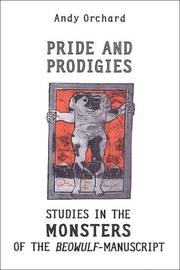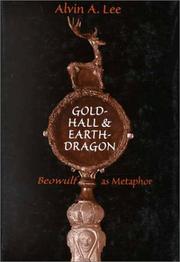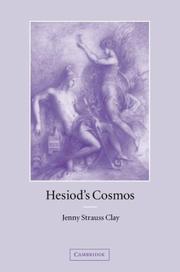| Listing 1 - 4 of 4 |
Sort by
|

ISBN: 0802085830 0802086675 144265709X Year: 2003 Publisher: Toronto, Ontario : Ottawa, Ontario : University of Toronto Press, Canadian Electronic Library,
Abstract | Keywords | Export | Availability | Bookmark
 Loading...
Loading...Choose an application
- Reference Manager
- EndNote
- RefWorks (Direct export to RefWorks)
In this series of detailed studies, Andy Orchard demonstrates the changing range of Anglo-Saxon attitudes towards the monstrous by reconsidering the monsters of Beowulf against the background of early medieval and patristic teratology and with reference to specific Anglo-Saxon texts.
Monsters in literature. --- Heroes in literature. --- Pride in literature. --- Epic poetry, English (Old) --- Monsters --- Christianity and literature --- Monstres dans la littérature --- Héros dans la littérature --- Orgueil dans la littérature --- Poésie épique anglaise --- Monstres --- Christianisme et littérature --- History and criticism. --- Religious aspects --- Christianity. --- Vieil anglais --- Histoire et critique --- Aspect religieux --- Christianisme --- Beowulf. --- Beowulf --- Manuscripts. --- Monstres dans la littérature --- Héros dans la littérature --- Orgueil dans la littérature --- Poésie épique anglaise --- Christianisme et littérature

ISBN: 080204378X 1442613122 9786612028755 1282028758 1442675403 9781442675407 9781282028753 9780802043788 Year: 1998 Publisher: Toronto Buffalo University of Toronto Press
Abstract | Keywords | Export | Availability | Bookmark
 Loading...
Loading...Choose an application
- Reference Manager
- EndNote
- RefWorks (Direct export to RefWorks)
The aim of Gold-Hall and Earth -Dragon is to re-create as fully as possible for modern readers the original force of the poetic language of Beowulf. Lee makes use of a wide, archetypal literary context for Beowulf to provide illuminating parallels and contrasts with poems and fictions from other times and places. He demonstrates how the poem's symbolic system reveals itself through the metaphorical workings of the Old English words, patterns of imagery, and more general narrative structures, and how the poem might have been experienced and interpreted by the Anglo-Saxons in the light of other Old English poems. The critical tools that Lee uses - combining certain techniques of New Criticism and close reading with postmodern theories of the self-referentiality of language and with Northrop Frye's conceptions of structure and polysemy in literature - make possible a fresh new account of Beowulf as a work that is very much alive in its poetic language, a finely wrought symbolic work of imagining, still resonant with meanings old and new.
Epic poetry, English (Old) --- English language --- Scandinavia in literature. --- Civilization, Anglo-Saxon. --- Monsters in literature. --- Dragons in literature. --- Heroes in literature. --- Rhetoric, Medieval. --- Metaphor. --- Poésie épique anglaise --- Anglais (Langue) --- Scandinavie dans la littérature --- Civilisation anglo-saxonne --- Monstres dans la littérature --- Dragons dans la littérature --- Héros dans la littérature --- Rhétorique médiévale --- Métaphore --- History and criticism. --- Vieil anglais --- Histoire et critique --- Beowulf. --- Parabole --- Anglo-Saxon civilization --- Anglo-Saxons --- Lexicology. --- Style. --- Civilization --- Bjowulf --- Scandinavia --- In literature. --- Figures of speech --- Reification --- Germanic languages --- Poésie épique anglaise --- Scandinavie dans la littérature --- Monstres dans la littérature --- Dragons dans la littérature --- Héros dans la littérature --- Rhétorique médiévale --- Métaphore
Book
ISBN: 9789004278370 9004278370 9789004283626 9004283625 1322348812 Year: 2015 Volume: 376 Publisher: Leiden
Abstract | Keywords | Export | Availability | Bookmark
 Loading...
Loading...Choose an application
- Reference Manager
- EndNote
- RefWorks (Direct export to RefWorks)
In Figures de l’épouvante grecques de l’antiquité au présent , Maria Patera examines an unfamiliar aspect of the Greek pedagogy of fear, illustrated by narratives about four Greek terrifying figures: Lamia, Mormô, Gellô and Empousa. These female bogeys belong to the children's world. Each of those figures provokes fear in a particular way, according to its own characteristics (metamorphosis, hybridity, cannibalism, et cetera). By means of a diachronic comparison of the ancient figures with their Byzantine and modern Greek namesakes, each of them is assigned a proper position within its specific historical, cultural, and religious context. Dans Figures de l’épouvante grecques de l’antiquité au présent , Maria Patera examine un aspect mal connu de la pédagogie grecque, celui de la peur, illustré à travers des récits principalement destinés aux enfants à propos des épouvantails Lamia, Mormô, Gellô et Empousa. Ces quatre figures féminines appartiennent aux chambres enfantines et aux contes de bonnes femmes. Chacune d’entre elles matérialise un aspect de l’épouvante à travers ses façons d’agir et ses traits caractéristiques (métamorphose, hybridité, anthropophagie, et cetera). Un examen diachronique permet de comparer les personnages anciens à leurs homonymes byzantins et néo-grecs et de déterminer leurs fonctions respectives dans chaque contexte historique, religieux et culturel donné.
Greek literature --- Byzantine literature --- Fear in literature. --- Children in literature. --- Ghosts in literature. --- Monsters in literature. --- Mythology, Greek --- Littérature grecque --- Littérature byzantine --- Peur dans la littérature --- Enfants dans la littérature --- Fantômes dans la littérature --- Monstres dans la littérature --- Mythologie grecque --- History and criticism. --- Psychological aspects --- Histoire et critique --- Aspect psychologique --- Fear in literature --- Children in literature --- Goddesses, Greek, in literature --- Ghosts in literature --- Monsters in literature --- History and criticism --- Littérature grecque --- Littérature byzantine --- Peur dans la littérature --- Enfants dans la littérature --- Fantômes dans la littérature --- Monstres dans la littérature --- Goddesses, Greek, in literature. --- Childhood in literature --- Children in poetry --- Greek literature - History and criticism --- Byzantine literature - History and criticism --- Mythology, Greek - Psychological aspects

ISBN: 1107137071 128043659X 0511180926 0511062141 0511205074 051130787X 0511482396 0511070608 9780511062148 9780511070600 9780521823920 0521823927 9781280436598 9780511307874 9786610436590 6610436592 9780511482397 9780521117685 0521117682 9781107137073 9780511180927 9780511205071 Year: 2003 Publisher: Cambridge, U.K. New York Cambridge University Press
Abstract | Keywords | Export | Availability | Bookmark
 Loading...
Loading...Choose an application
- Reference Manager
- EndNote
- RefWorks (Direct export to RefWorks)
"Hesiod's Cosmos offers a comprehensive interpretation of both the Theogony and the Works and Days and demonstrates how the two Hesiodic poems must be read together as two halves of an integrated whole embracing both the divine and the human cosmos. After first offering a survey of the structure of both poems, Professor Clay reveals their mutually illuminating unity by offering detailed analyses of their respective poems, their teachings on the origins of the human race, and the two versions of the Prometheus myth. She then examines the role of human beings in the Theogony and the role of the gods in the Works and Days, as well as the position of the hybrid figures of monsters and heroes within the Hesiodic cosmos and in relation to the Hesiodic Catalogue of Women."--Jacket.
Religious poetry, Greek --- Didactic poetry, Greek --- Cosmology, Ancient, in literature. --- Mythology, Greek, in literature. --- Human beings in literature. --- Gods, Greek, in literature. --- Monsters in literature. --- Man in literature --- Greek religious poetry --- Greek poetry --- History and criticism. --- Hesiod. --- Hesiod --- Gesiod --- Geziod --- Esiodo --- Hēsiodos --- Hezjod --- Hésiode --- Hesíodo --- Hesiyodos --- הסיודוס --- Ἡσίοδος --- Knowledge --- Cosmology. --- Cosmology, Ancient, in literature --- Gods, Greek, in literature --- Human beings in literature --- Monsters in literature --- Mythology, Greek, in literature --- History and criticism --- Hesiodus --- Cosmology --- Religious poetry [Greek ] --- Didactic poetry [Greek ] --- Cosmology [Ancient ] in literature --- Mythology [Greek ] in literature --- Gods [Greek ] in literature --- Alceste (Mythologie grecque) dans la littérature. --- Cosmologie antique dans la littérature. --- Didactic poetry, Greek. --- Dieux grecs dans la littérature. --- Homme dans la littérature. --- Kosmologie. --- Literatura grega. --- Monstres dans la littérature. --- Poésie didactique grecque --- Poésie religieuse --- Religious poetry, Greek. --- Wereldbeeld. --- Histoire et critique. --- Hesiodus, --- Hésiode --- Hésiode. --- Hesiodo. --- Hesiodus. --- Et la cosmologie. --- Theogony (Hesiod). --- Works and days (Hesiod). --- Arts and Humanities --- History --- Religious poetry, Greek - History and criticism --- Didactic poetry, Greek - History and criticism --- Hesiod - Theogony --- Hesiod - Works and days --- Hesiod - Knowledge - Cosmology
| Listing 1 - 4 of 4 |
Sort by
|

 Search
Search Feedback
Feedback About UniCat
About UniCat  Help
Help News
News